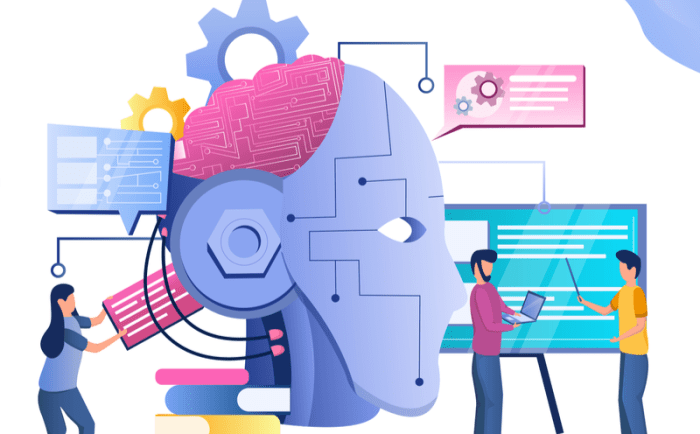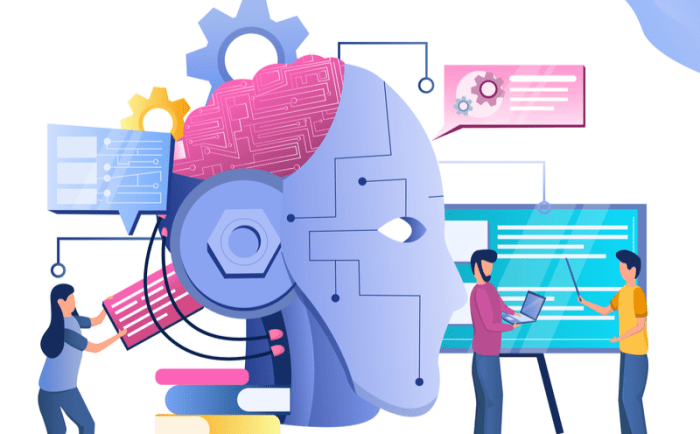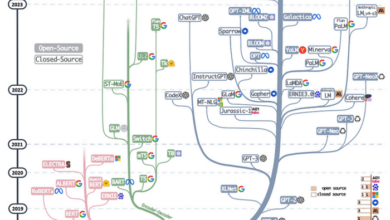
Beginner Start Machine Learning: Your Guide to AI
Beginner start machine learning – it might sound intimidating, but it’s actually an exciting journey into the world of artificial intelligence. Imagine building a program that can predict the weather, analyze customer data, or even create art. That’s the power of machine learning, and you can be a part of it!
This blog post will be your friendly guide, walking you through the basics of machine learning. We’ll cover essential concepts, tools, and even build your very first machine learning model. So, whether you’re a complete beginner or have some coding experience, get ready to dive in!
Understanding Machine Learning Basics: Beginner Start Machine Learning
Machine learning (ML) is a fascinating field that empowers computers to learn from data without explicit programming. It’s like teaching a computer to recognize patterns and make predictions based on what it has learned. Imagine a child learning to identify different fruits – they see various fruits, observe their colors, shapes, and textures, and gradually learn to distinguish them.
Similarly, ML algorithms “learn” from data, identifying patterns and relationships to make predictions or decisions.
Types of Machine Learning
Machine learning can be categorized into three main types: supervised learning, unsupervised learning, and reinforcement learning. Each type has its unique approach and applications.
Supervised Learning
Supervised learning involves training a model on labeled data, where each data point has a corresponding output or target value. This process is akin to providing a student with a set of questions and their correct answers to help them learn the subject.
- Example:Imagine you want to create a model that predicts the price of a house based on its size, location, and number of bedrooms. You would provide the model with a dataset of past house sales, including the price (target value) and relevant features (size, location, number of bedrooms).
The model learns the relationship between these features and the price, enabling it to predict the price of new houses.
Unsupervised Learning
Unsupervised learning deals with unlabeled data, where the model must discover patterns and structures without explicit guidance. It’s like giving a student a set of images and asking them to identify common themes or patterns.
- Example:Customer segmentation is a common unsupervised learning application. A company might use an unsupervised learning algorithm to group its customers based on their purchasing behavior, demographics, or other characteristics. This information can then be used to tailor marketing campaigns and improve customer service.
Reinforcement Learning
Reinforcement learning involves training a model to make decisions in an environment by maximizing rewards. The model learns through trial and error, receiving feedback in the form of rewards or penalties for its actions. It’s like teaching a dog a new trick by rewarding it for desired behavior.
- Example:Self-driving cars are a prime example of reinforcement learning. The car learns to navigate roads and make decisions based on its interactions with the environment. It receives rewards for safe driving and penalties for accidents or traffic violations. Through this process, the car gradually improves its driving skills.
Machine Learning vs. Traditional Programming
Machine learning differs significantly from traditional programming. In traditional programming, developers explicitly write code to perform specific tasks. This approach requires a deep understanding of the problem and the ability to define precise steps for solving it. In contrast, machine learning allows computers to learn from data and discover patterns that might not be obvious to humans.
- Traditional programming:You provide explicit instructions to the computer, telling it exactly what to do.
- Machine learning:You provide data to the computer and let it learn from that data to perform tasks.
Machine learning is particularly powerful when dealing with complex problems that are difficult to solve through traditional programming, such as image recognition, natural language processing, and fraud detection.
Essential Tools and Technologies

Machine learning, a powerful field that allows computers to learn from data, relies on a robust ecosystem of tools and technologies. Understanding these tools is crucial for anyone embarking on a machine learning journey. This section delves into the essential components that underpin machine learning development.
Programming Languages
Programming languages form the foundation for implementing machine learning algorithms. Python, R, and Java are popular choices, each offering unique strengths and advantages.
- Python: Python’s simplicity, readability, and extensive libraries, such as NumPy, Pandas, and scikit-learn, make it a favorite among machine learning practitioners. Its vast community support and abundance of resources further solidify its position as a go-to language.
- R: R excels in statistical computing and data visualization, making it a powerful tool for exploratory data analysis and statistical modeling. Its comprehensive libraries, such as dplyr, tidyr, and ggplot2, facilitate data manipulation and visualization.
- Java: Java’s robustness, scalability, and enterprise-level support make it suitable for large-scale machine learning projects. Libraries like Weka and Deeplearning4j provide tools for building and deploying machine learning models.
Libraries and Frameworks, Beginner start machine learning
Libraries and frameworks provide pre-built components and tools that streamline machine learning development. These libraries offer functionalities for data preprocessing, model training, evaluation, and deployment.
- TensorFlow: TensorFlow is a popular open-source library developed by Google. It excels in deep learning tasks, providing tools for building and training neural networks. Its flexibility and scalability make it suitable for various machine learning applications.
- PyTorch: PyTorch, another open-source library, is known for its ease of use and flexibility. It allows for dynamic computational graphs, making it ideal for research and prototyping. Its popularity has grown significantly in recent years.
- scikit-learn: scikit-learn is a comprehensive library that provides tools for various machine learning tasks, including classification, regression, clustering, and dimensionality reduction. Its user-friendly interface and wide range of algorithms make it a valuable resource for beginners and experienced practitioners alike.
Cloud Platforms
Cloud platforms play a crucial role in machine learning development, providing infrastructure, storage, and computational resources. They offer scalable solutions for training and deploying models, enabling efficient and cost-effective machine learning development.
- Google Cloud: Google Cloud provides a comprehensive suite of machine learning services, including pre-trained models, AutoML, and Vertex AI. Its robust infrastructure and advanced AI capabilities make it a popular choice for businesses of all sizes.
- AWS: Amazon Web Services offers a wide range of machine learning services, including Amazon SageMaker, Amazon Rekognition, and Amazon Comprehend. Its extensive ecosystem and global reach make it a strong contender in the cloud computing market.
- Azure: Microsoft Azure provides a platform for building, deploying, and managing machine learning models. Its Azure Machine Learning service offers tools for data preparation, model training, and deployment, along with pre-built models and custom model development capabilities.
Setting Up Your Machine Learning Environment
Before diving into the fascinating world of machine learning, you need to set up a suitable environment. This involves installing the necessary software and tools to write, run, and experiment with your machine learning code.
Installing Python and Essential Machine Learning Libraries
Python is the go-to language for machine learning due to its simplicity, readability, and vast collection of libraries specifically designed for data science and machine learning tasks. Here’s a step-by-step guide to install Python and essential libraries:
- Download Python:Visit the official Python website (https://www.python.org/) and download the latest version of Python for your operating system (Windows, macOS, or Linux).
- Run the Installer:Run the downloaded installer and follow the on-screen instructions to install Python on your system. Make sure to check the box to add Python to your system’s PATH environment variable during installation.
This will allow you to run Python from any directory in your terminal or command prompt.
- Install pip:Python comes with a package installer called ‘pip’. You can use pip to install various Python packages and libraries. To check if pip is installed, open your terminal or command prompt and run the command:
pip-version
If pip is installed, you will see its version number.
- Install Essential Machine Learning Libraries:Once you have Python and pip installed, you can install the essential machine learning libraries using pip. Here are some popular libraries you’ll likely use:
- NumPy:A fundamental library for numerical computing in Python, providing powerful tools for working with arrays, matrices, and mathematical operations.
Install NumPy using:
pip install numpy - Pandas:A data manipulation and analysis library that provides data structures like DataFrames for efficiently working with structured data. Install Pandas using:
pip install pandas - Scikit-learn (sklearn):A comprehensive machine learning library offering a wide range of algorithms for classification, regression, clustering, and more. Install Scikit-learn using:
pip install scikit-learn - Matplotlib:A popular library for creating static, animated, and interactive visualizations in Python. Install Matplotlib using:
pip install matplotlib - Seaborn:A library built on top of Matplotlib, offering high-level statistical data visualization tools for creating aesthetically pleasing and informative plots. Install Seaborn using:
pip install seaborn
- NumPy:A fundamental library for numerical computing in Python, providing powerful tools for working with arrays, matrices, and mathematical operations.
Setting Up Jupyter Notebook
Jupyter Notebook is an interactive web-based environment that allows you to write and execute Python code, create visualizations, and document your work in a single document. It’s an excellent tool for experimenting with machine learning concepts and building prototypes.
- Install Jupyter Notebook:You can install Jupyter Notebook using pip:
pip install jupyter - Launch Jupyter Notebook:Once installed, you can launch Jupyter Notebook by running the command:
jupyter notebookThis will open a new tab in your web browser, displaying the Jupyter Notebook dashboard.
- Create a New Notebook:From the dashboard, you can create a new notebook by clicking on the “New” button and selecting “Python 3.” This will create a new notebook file with a .ipynb extension.
- Write and Execute Code:Jupyter Notebook allows you to write Python code in cells.
To execute a cell, press Shift + Enter. The output of the code will be displayed below the cell.
Understanding Virtual Environments
Virtual environments are essential for managing dependencies in Python projects, especially when working with machine learning projects that often require different versions of libraries for different projects.
- Why Virtual Environments?Imagine working on two machine learning projects, one using Scikit-learn version 0.20 and the other using version 0.24. If you install both versions globally, you might encounter conflicts or unexpected behavior. Virtual environments create isolated environments for each project, allowing you to install and manage different versions of libraries without interfering with other projects.
- Creating Virtual Environments:Python offers a built-in module called ‘venv’ for creating virtual environments. To create a virtual environment for your machine learning project, navigate to your project directory in your terminal or command prompt and run:
pythonm venv my_env
This will create a new directory called ‘my_env’ containing the virtual environment.
Starting out with machine learning can feel overwhelming, especially when juggling multiple tasks and deadlines. A solid workflow is key to staying organized, and that’s where best workflow management software can be a lifesaver. By breaking down your projects into manageable steps, you can track progress, prioritize tasks, and avoid getting bogged down in the details.
This helps you stay focused on learning and experimenting with machine learning concepts, which is ultimately what will lead to success.
- Activating Virtual Environments:To use the virtual environment, you need to activate it. The activation command varies depending on your operating system:
- Windows:
my_env\Scripts\activate - macOS/Linux:
source my_env/bin/activate
- Windows:
- Installing Libraries in Virtual Environments:Once activated, you can install libraries within the virtual environment using pip. For example, to install NumPy:
pip install numpy - Deactivating Virtual Environments:To deactivate the virtual environment, simply run:
deactivate
Fundamental Machine Learning Concepts
Before diving into the practical aspects of machine learning, let’s understand the core concepts that underpin this fascinating field. These concepts form the foundation for building and interpreting machine learning models.
Jumping into machine learning can feel daunting, but with the right resources, you can start building your skills. One key aspect to understand is the difference between data governance and data management, as they both play crucial roles in the success of your projects.
Data governance vs data management is an important distinction to grasp when you’re working with large datasets, ensuring that your data is both reliable and used ethically. This understanding will help you build solid foundations for your machine learning journey, enabling you to tackle complex problems with confidence.
Datasets
Datasets are the lifeblood of machine learning. They consist of a collection of data points, each representing an observation or instance. Each data point has multiple attributes, also known as features, that describe different aspects of the observation. For example, a dataset of house prices might include features like the number of bedrooms, square footage, location, and year built.
Features
Features are the individual characteristics or attributes of each data point in a dataset. They provide the information that the machine learning model uses to make predictions. Features can be numerical, categorical, or textual, depending on the nature of the data.
For instance, in a dataset of customer purchase history, features could include age, gender, purchase amount, and product category.
Labels
Labels are the target values or outcomes that we want to predict using machine learning. They represent the desired output or classification for each data point. For example, in a dataset of loan applications, the label might be whether the applicant is likely to default on the loan (yes or no).
Models
Machine learning models are mathematical representations of the relationships between features and labels. They are trained on a dataset to learn these relationships and make predictions on new, unseen data. The goal is to build a model that can accurately predict the labels for new data points based on their features.
Algorithms
Machine learning algorithms are the specific methods used to train and build models. Each algorithm has its own strengths and weaknesses, and the choice of algorithm depends on the nature of the data and the task at hand. Common algorithms include linear regression, logistic regression, decision trees, and support vector machines.
Data Preprocessing and Cleaning
Before feeding data into a machine learning model, it’s crucial to preprocess and clean it. This involves handling missing values, transforming data into a suitable format, and removing outliers or irrelevant information.
- Handling Missing Values:Missing values can be addressed by imputation techniques, where missing values are filled in based on other available data.
- Data Transformation:Transforming data to a common scale or distribution can improve model performance. Techniques include standardization, normalization, and encoding categorical variables.
- Outlier Removal:Outliers are data points that are significantly different from other data points and can distort model training. Techniques for outlier removal include identifying and removing extreme values or using robust statistical methods.
Types of Machine Learning Models
Machine learning models can be broadly categorized into supervised, unsupervised, and reinforcement learning.
Supervised Learning
Supervised learning involves training a model on labeled data, where the model learns to predict the labels for new data points based on the relationships observed in the training data.
- Linear Regression:This algorithm is used for predicting continuous target variables, such as house prices or stock prices. It assumes a linear relationship between the features and the target variable.
- Logistic Regression:This algorithm is used for predicting categorical target variables, such as whether a customer will click on an ad or not. It uses a sigmoid function to map the linear relationship between features and the target variable to a probability between 0 and 1.
- Decision Trees:These algorithms build a tree-like structure to represent the relationships between features and the target variable. They use a series of if-then-else rules to make predictions.
- Support Vector Machines (SVMs):SVMs are powerful algorithms that find the optimal hyperplane that separates data points belonging to different classes. They are often used for classification tasks, especially when dealing with high-dimensional data.
Unsupervised Learning
Unsupervised learning involves training a model on unlabeled data, where the model learns to discover patterns and structures in the data without explicit guidance.
- Clustering:This technique groups similar data points together based on their features. Common clustering algorithms include k-means clustering and hierarchical clustering.
- Dimensionality Reduction:This technique reduces the number of features in a dataset while preserving as much information as possible. Techniques include Principal Component Analysis (PCA) and t-SNE.
Reinforcement Learning
Reinforcement learning involves training an agent to interact with an environment and learn through trial and error. The agent receives rewards for taking actions that lead to desirable outcomes and penalties for taking actions that lead to undesirable outcomes.
Building Your First Machine Learning Model
This section guides you through the process of building your first machine learning model, using a real-world dataset. We’ll cover data exploration, feature engineering, model training, and evaluation. By the end, you’ll have a working model that can make predictions based on the data you provide.
Data Exploration
Data exploration is the first step in any machine learning project. This involves understanding the data you’re working with, its characteristics, and identifying potential patterns or insights.For this project, we’ll use the popular Iris dataset, which contains measurements of sepal and petal lengths and widths for three species of Iris flowers.The Iris dataset is a classic dataset in machine learning.
It contains information about 150 Iris flowers, with 50 samples from each of three species: Iris setosa, Iris versicolor, and Iris virginica. Each sample has four features: sepal length, sepal width, petal length, and petal width. The dataset is often used to demonstrate basic machine learning concepts, such as classification and clustering.We’ll use Python and the Pandas library for data exploration.
Pandas provides powerful tools for data manipulation and analysis.Here’s a code snippet to load the Iris dataset and display its first few rows:“`pythonimport pandas as pdfrom sklearn.datasets import load_iris# Load the Iris datasetiris = load_iris()# Create a Pandas DataFrame from the datadf = pd.DataFrame(data=iris.data, columns=iris.feature_names)# Display the first 5 rows of the DataFrameprint(df.head())“`This code will output a table with the first five rows of the Iris dataset.
Feature Engineering
Feature engineering involves selecting and transforming the features in your dataset to improve the performance of your machine learning model. This often involves creating new features from existing ones or removing irrelevant features.For example, we could create a new feature called “petal area” by multiplying the petal length and width.“`python# Create a new feature called ‘petal_area’df[‘petal_area’] = df[‘petal length (cm)’]
Starting out in machine learning can feel like tackling a complex puzzle, but breaking it down into smaller steps helps. Just like crafting a plush fox doll DIY project, you begin with a clear plan, gather your materials (data sets, algorithms), and then work through each stage, iterating and refining as you go.
The satisfaction of seeing your machine learning model come to life is just as rewarding as completing a plush fox doll!
df[‘petal width (cm)’]
“`
Model Training
Once you have prepared your data, you can train a machine learning model. The model will learn from the data and develop a relationship between the features and the target variable.For this project, we’ll use a simple linear regression model to predict the petal length based on the other features.“`pythonfrom sklearn.model_selection import train_test_splitfrom sklearn.linear_model import LinearRegression# Split the data into training and testing setsX_train, X_test, y_train, y_test = train_test_split( df.drop(‘petal length (cm)’, axis=1), df[‘petal length (cm)’], test_size=0.2, random_state=42)# Create a linear regression modelmodel = LinearRegression()# Train the model on the training datamodel.fit(X_train, y_train)“`
Model Evaluation
After training the model, you need to evaluate its performance. This involves using the trained model to make predictions on unseen data and comparing those predictions to the actual values.“`python# Make predictions on the testing datay_pred = model.predict(X_test)# Evaluate the model’s performancefrom sklearn.metrics import mean_squared_errormse = mean_squared_error(y_test, y_pred)print(f’Mean Squared Error: mse’)“`This code will calculate the mean squared error (MSE) between the predicted petal lengths and the actual petal lengths.
A lower MSE indicates a better model performance.
Further Steps
Once you have a working model, you can experiment with different features, models, and hyperparameters to improve its performance. You can also explore more complex machine learning techniques like decision trees, support vector machines, and neural networks.
Practical Applications of Machine Learning
Machine learning is no longer a futuristic concept; it’s deeply integrated into our daily lives, quietly shaping our experiences and driving innovation across various industries. From the personalized recommendations we receive on streaming platforms to the fraud detection systems safeguarding our financial transactions, machine learning is revolutionizing how we interact with technology and the world around us.
Let’s explore some compelling real-world examples of how machine learning is transforming various sectors.
Image Recognition
Image recognition, a core application of machine learning, enables computers to “see” and interpret images like humans do. This technology has a wide range of applications, including:
- Medical Diagnosis:Machine learning algorithms can analyze medical images like X-rays, MRIs, and CT scans to detect abnormalities and assist doctors in making accurate diagnoses. This can significantly improve the speed and accuracy of disease detection, leading to earlier interventions and better patient outcomes.
- Self-Driving Cars:Autonomous vehicles rely heavily on image recognition to navigate roads safely. These systems use cameras and sensors to identify objects like pedestrians, traffic signals, and other vehicles, allowing them to make informed decisions about speed, direction, and braking.
- Facial Recognition:This technology uses image recognition to identify individuals based on their facial features. It has applications in security systems, law enforcement, and even unlocking smartphones.
Natural Language Processing
Natural language processing (NLP) focuses on enabling computers to understand, interpret, and generate human language. This powerful technology has applications in:
- Chatbots and Virtual Assistants:NLP powers chatbots and virtual assistants like Siri, Alexa, and Google Assistant. These systems can understand your voice commands, answer your questions, and even engage in conversations.
- Machine Translation:NLP is the driving force behind real-time translation services like Google Translate and DeepL. These tools can translate text and speech between multiple languages, breaking down communication barriers.
- Sentiment Analysis:Businesses use NLP to analyze customer reviews, social media posts, and other textual data to understand public sentiment towards their products or services. This allows them to make informed decisions about marketing strategies and product development.
Predictive Analytics
Predictive analytics leverages machine learning to analyze historical data and identify patterns that can be used to predict future outcomes. This has applications in:
- Financial Forecasting:Banks and investment firms use predictive analytics to forecast market trends, identify investment opportunities, and manage risk. Machine learning algorithms can analyze vast amounts of financial data, including stock prices, economic indicators, and news articles, to predict future market movements.
- Customer Churn Prediction:Businesses can use machine learning to predict which customers are likely to churn (stop using their services). This allows them to proactively reach out to at-risk customers and offer incentives to retain them.
- Fraud Detection:Machine learning algorithms are used to identify fraudulent transactions in real-time. By analyzing patterns in historical data, these systems can detect anomalies and flag suspicious activities, helping to prevent financial losses.
Ethical Considerations and Bias
While machine learning offers incredible potential, it’s crucial to acknowledge the ethical considerations and potential biases associated with these technologies.
- Bias in Data:Machine learning models are trained on data, and if the data is biased, the model will inherit those biases. This can lead to discriminatory outcomes, especially in areas like hiring, lending, and criminal justice.
- Transparency and Explainability:Some machine learning models, particularly deep neural networks, are complex and difficult to interpret. This lack of transparency can raise concerns about accountability and fairness.
- Privacy and Security:Machine learning often involves collecting and analyzing large amounts of personal data, raising concerns about privacy and data security.
Resources for Further Learning
The journey into machine learning is continuous. There are countless resources available to help you delve deeper into the field and stay updated with the latest advancements. Whether you prefer interactive courses, hands-on tutorials, or comprehensive books, there’s something for everyone.
Online Courses and Tutorials
Online courses and tutorials provide a structured learning path with interactive exercises and real-world projects. They are an excellent way to gain practical experience and build a solid foundation in machine learning.
- Coursera:Offers a wide range of machine learning courses from top universities and institutions, including “Machine Learning” by Andrew Ng, one of the most popular and comprehensive introductory courses.
- edX:Provides a similar platform with courses like “Machine Learning” by Columbia University, which focuses on the mathematical foundations and practical applications of machine learning.
- Udacity:Specializes in nanodegree programs, including “Machine Learning Engineer” and “AI Programming with Python,” which provide a comprehensive learning experience with industry-relevant projects.
- DataCamp:Offers interactive data science and machine learning courses, with a focus on practical skills and real-world applications.
- Kaggle Learn:Provides free tutorials and courses on machine learning, deep learning, and data science, with a focus on hands-on projects and competitions.
Books
Books offer a deeper dive into the theoretical foundations and advanced concepts of machine learning. They provide a comprehensive understanding of the field and serve as valuable references for further exploration.
- “Hands-On Machine Learning with Scikit-Learn, Keras & TensorFlow” by Aurélien Géron:A practical guide to machine learning using Python libraries, covering various algorithms and techniques.
- “Introduction to Machine Learning with Python” by Andreas Müller and Sarah Guido:A beginner-friendly introduction to machine learning using Python, covering essential concepts and algorithms.
- “The Elements of Statistical Learning” by Trevor Hastie, Robert Tibshirani, and Jerome Friedman:A classic textbook covering statistical learning theory and methods, widely used in academia and industry.
- “Deep Learning” by Ian Goodfellow, Yoshua Bengio, and Aaron Courville:A comprehensive introduction to deep learning, covering its theoretical foundations, algorithms, and applications.
Communities and Forums
Connecting with other machine learning enthusiasts can provide valuable insights, support, and guidance. Engaging in online communities and forums allows you to ask questions, share your experiences, and learn from others.
- Reddit:The r/MachineLearning subreddit is a vibrant community where you can find discussions, news, and resources related to machine learning.
- Stack Overflow:A popular platform for asking and answering programming questions, including those related to machine learning.
- Kaggle:A platform for data science and machine learning competitions, with a strong community of practitioners and learners.
- Discourse:Many machine learning libraries and frameworks have dedicated forums on Discourse, where you can find discussions, tutorials, and support.
Ongoing Learning and Exploration
Machine learning is a rapidly evolving field. Continuous learning and exploration are crucial to staying ahead of the curve.
- Follow industry blogs and publications:Stay updated on the latest research, trends, and advancements in machine learning by subscribing to blogs and publications such as Towards Data Science, Machine Learning Mastery, and Analytics Vidhya.
- Attend conferences and workshops:Conferences and workshops provide opportunities to learn from experts, network with peers, and stay up-to-date on the latest developments.
- Contribute to open-source projects:Contributing to open-source projects can be a rewarding way to learn and contribute to the machine learning community.







